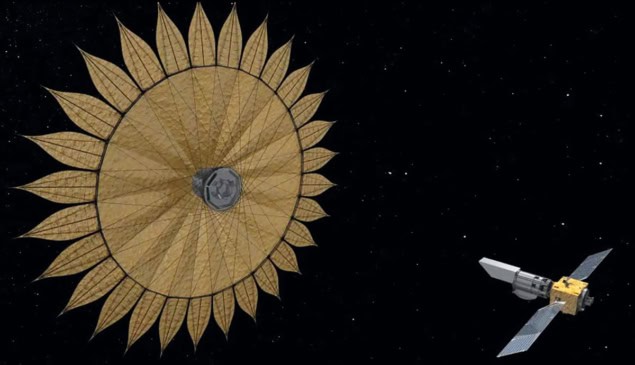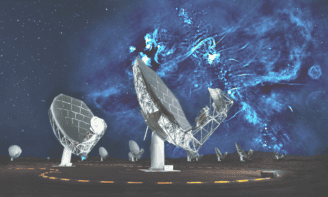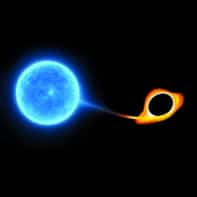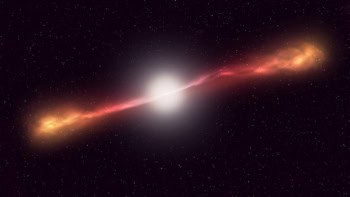A recently published report describes a “starshade” currently being developed that would resemble a giant sunflower floating in space. As Liz Kruesi reports, the instrument could allow astronomers to image starlight reflected from exoplanets by cutting the glare from their parent star

The search for life beyond Earth is what drives much of astronomy. In 1992 scientists came closer to the goal of finding it when they began detecting planets around stars other than the Sun by observing the ways those worlds affect the light or their parent star. No signs of life have yet been discovered, but a new instrument being developed by NASA could change that within the next couple of decades.
Once in space, this “starshade” would block the light from a star in the hope that a telescope flying in formation with it could see the starlight reflected off that star’s exoplanets. Astronomers would then use an onboard spectrometer to study absorption lines in the reflected light, looking for hints of an atmosphere around any of the exoplanets. They are specifically looking for significant amounts of carbon dioxide, oxygen and methane – “biosignatures” that would suggest life on the exoplanet.
But an Earth-like exoplanet that lies as far from its Sun-like star as our Earth is from the Sun is hard to see. The planet reflects so little light that it glows at just one 10-billionth of the star’s brightness. It is like seeing a firefly buzzing around a spotlight, except that the spotlight and firefly are in New York City and the observer is in Los Angeles.
Sunflower shade
Exoplanet scientists therefore need to find a way to block the light streaming from the star, which is where a starshade comes in. By flying separately from a telescope, it can be precisely aligned to block the starlight. The beauty of such an instrument is that, even when paired with just a small telescope, say 1 m or 2 m in diameter, it could find signs of life.
The shape of that starshade matters. As light behaves like a wave, a simple disc will not work. A pinpoint of light from a star striking a disc would create a diffraction pattern that would overwhelm the signal from an exoplanet. Of course, you can never stop diffraction, but you can lessen its effects.
Computer modelling led by Jeremy Kasdin of Princeton University in the US has guided scientists to the ideal starshade shape: a disc with at least 20 petals attached along the disc’s edge, similar to a sunflower. “The petals redirect the light away from the telescope, so the telescope now sits in the shadow that’s created by the starshade,” says Nick Siegler, technology manager of NASA’s Exoplanet Exploration Program.
To further study the idea of a starshade that flies separately to a telescope, NASA commissioned a report a few years ago that was released earlier this year. “One of the goals of the study was to come up with the things that have to be done, and how much will they cost, and how hard do we think they are,” says Sara Seager, an exoplanet scientist at the Massachusetts Institute of Technology who chaired the study. While the technology is not yet ready, Seager and her colleagues have no doubt that a starshade could be on track for launch within a decade.
There are many hurdles that scientists and engineers must overcome to build a starshade, but Seager does not see “any major showstoppers with this technology, based on heritage or ongoing technology development”. However, one major obstacle is how to deploy the starshade once it is built. Some 30–40 m wide, the structure would be much too large to fit into the 4 m wide fairing of a rocket. Instead, current designs envisage collapsing the central disc using a method inspired by origami and then curling the petals around that central region. Once in space, the starshade “has to deploy to exactly the right positions”, says Kasdin. “All the petals have to go to the same place, within about half a millimetre,” he says.
Formation flying
The starshade then needs to move 50,000 km away from the telescope but remain aligned to no more than 1 m from the line of sight to the stellar target. Space agencies have used a similar kind of formation flying for decades, for example to dock a capsule to the International Space Station. The challenge, says Siegler, is that “the telescope has to sense where the starshade is and then it has to correct its position”.

Another potential concern is light scattered from the Sun. The starshade will be aligned edge-on to our Sun, but glinting sunlight on the petal edges could overwhelm the faint signals from exoplanets. “We know that the edges are going to need to be sharp, we know it needs to be dark,” says Steve Warwick, starshade programme manager at the US-based aerospace firm Northrop Grumman. “The research at the moment is how sharp and how dark.” Research at NASA’s Jet Propulsion Laboratory suggests the edges can be only a few microns thick, but Northrop Grumman studies suggest about 40 μm. NASA has issued contracts for both teams to study this issue further to determine the required specifications.
While the starshade edges will be razor sharp, the central disc and most of the surface area of the petals will be made of some thicker material. The current work is looking at a membrane two or three layers thick. The edges’ maximum allowed thickness will affect how scientists work with the material of the entire structure, how the starshade collapses in the rocket fairing, and how it deploys. “If it touches anything, it’s going to either bend the razor end or rip the membrane,” warns Siegler.
Technology challenges
Of the technologies required for a starshade to be launch-ready, Warwick considers this edge-scatter problem the most difficult. Another obstacle, he adds, is making sure that as all the technologies are brought together, the starshade is a working system. And testing this full system will be impossible on the ground.
What scientists really want is to launch a full-scale starshade alongside a proposed future NASA mission – the 2.4 m diameter Wide-Field Infrared Survey Telescope (WFIRST). The separate starshade would not be part of this mission’s budget, and the WFIRST craft would need only a few minor instrument modifications onboard to make it operational with a starshade rendezvous, says Siegler. And even if the starshade–WFIRST combination cannot suppress enough light to study Earth-like planets orbiting their stars, the combination will still give researchers incredibly important data. They would be running a full-scale technology test that sets the stage for the next possible mission in the 2030s of a larger telescope, and beyond. “We’d like to see every telescope that gets launched to be starshade-ready,” says Seager.
The scientists involved with this technology development are all looking forward to the next few decades of starshade work. “It is incredibly exciting to work on something that gives us the best chance of finding life outside of Earth,” says Warwick. “And that’s what gets me up in the morning.”



